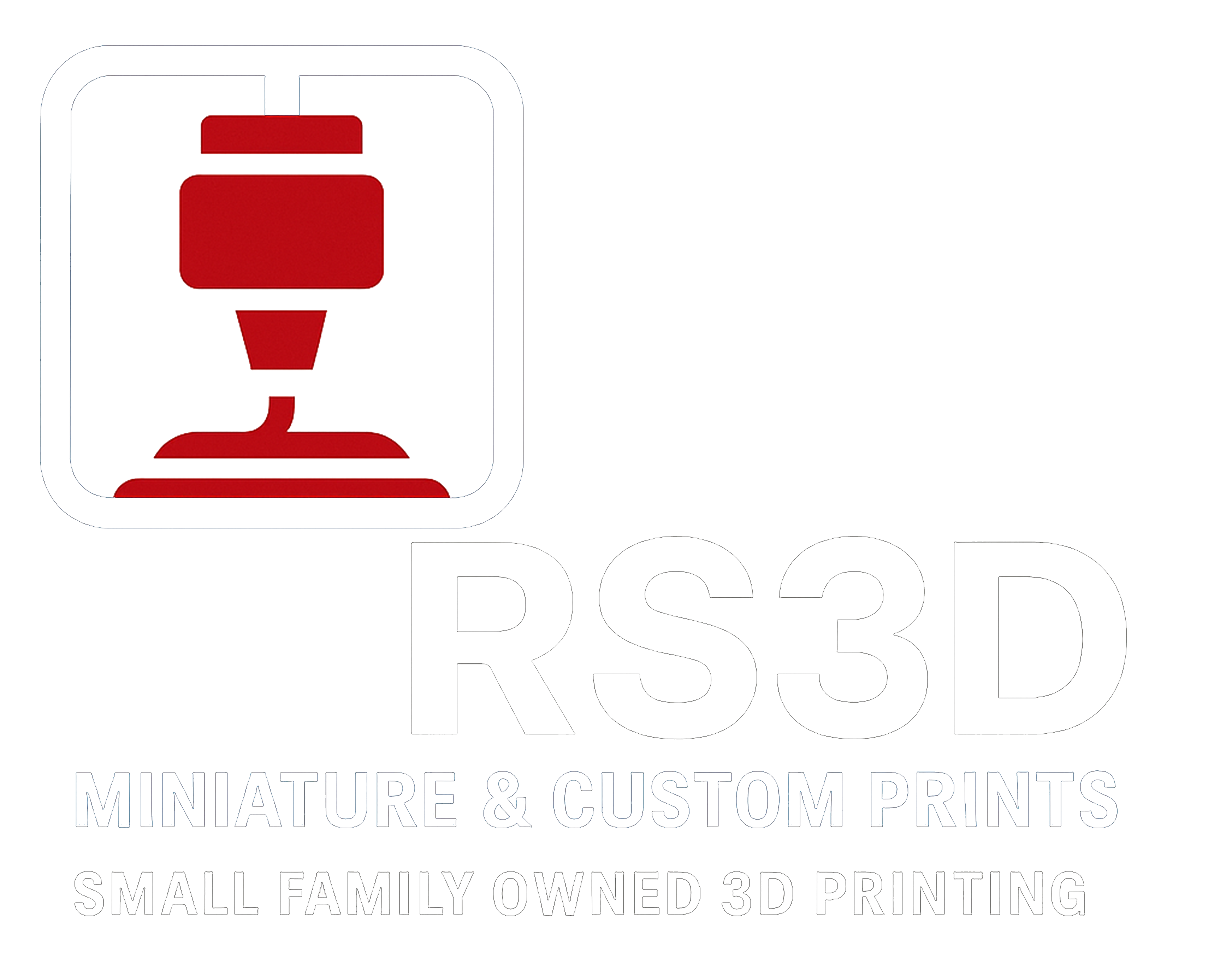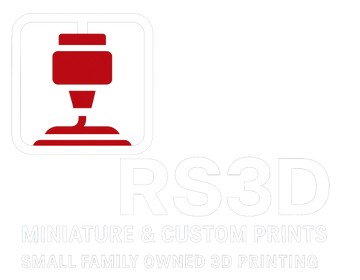🧵 About Our 3D Printing Filament – RS3D
A Complete, Easy-to-Understand Guide for Our Customers
Welcome to RS3D’s comprehensive filament guide. Whether you’re new to 3D printing or just curious about the materials behind our products, this page explains the differences between common filament types, specialty materials, recycled options, and how we choose the safest and most reliable options for your prints.
Our goal: Help you understand what your RS3D prints are made of — and why we choose the materials we do.
From toys to collectibles, décor to functional parts, we print with materials that are biodegradable, durable, flexible, safe for home use, and environmentally responsible.
🧪 What Is 3D Printer Filament?
FDM (Fused Deposition Modeling) 3D printers — like the ones we use at RS3D — build objects layer by layer using melted thermoplastic filament.
-
Filament comes on spools
-
Standard size: 1.75mm
-
It’s fed through the extruder
-
Melted in the hotend
-
Then deposited through a heated nozzle
-
Repeated hundreds or thousands of times to create the final object
Each filament type has different properties like flexibility, strength, heat resistance, and print settings. Choosing the right one depends on what the item is meant to do.
🔍 Filament Types Used by RS3D
We primarily use the “Six Basics” of 3D printing, plus select specialty materials. These cover 99% of real-world printing needs.
✅ The Six Basics
🌱 PLA (Polylactic Acid) — Eco-Friendly, Easy, and Beautiful
Source: Corn starch, sugarcane, and other renewable resources
Strength: Medium
Flexibility: Low
Durability: Medium
Print Difficulty: Very easy
Bed Requirement: None or low temp
Temperature: 180–230°C
PLA is the #1 most-used filament in the world — around half of the entire filament market.
Why we use it:
-
Great for toys, miniatures, and décor
-
Minimal warping
-
Wide color variety (silks, rainbows, matte, glitter)
-
Low odor
-
Plant-based and biodegradable under industrial composting
Why we don’t use PLA for everything:
It becomes soft at ~60°C and can deform if left in hot cars, direct sunlight, or outdoors long-term.
Best for:
✅ Toys
✅ Figures
✅ Cosplay pieces
✅ Signs
✅ Night lights
✅ Keychains
💪 ABS (Acrylonitrile Butadiene Styrene) — Tough, Impact-Resistant
Strength: High
Flexibility: Medium
Durability: High
Temp Resistance: Excellent
Print Difficulty: Medium–hard (fumes, warping)
We rarely use ABS at RS3D because:
-
It requires very high heat
-
Produces strong fumes
-
Warps without a fully enclosed chamber
But ABS is excellent for:
-
Heavy-wear toys
-
Vehicle parts
-
Durable functional items
💎 PETG (Polyethylene Terephthalate Glycol) — Strong, Clean, Recyclable
Strength: High
Flexibility: Medium
Durability: High
Print Difficulty: Medium
Temp: 220–250°C
PETG is like the best traits of PLA and ABS combined:
✅ Strong
✅ UV-resistant
✅ Moisture-resistant
✅ Food-safe variants exist
✅ Recyclable as #1 plastic
We use PETG for:
-
Durable décor
-
Vases
-
Parts that may be handled frequently
-
Items that must resist sun, moisture, or stress
🧼 TPU (Thermoplastic Polyurethane) — Flexible & Shock-Absorbent
Strength: High
Flexibility: Very high
Durability: Very high
Use Difficulty: Medium (requires tuned settings)
TPU is rubber-like and perfect for:
✅ Fidget toys
✅ Phone cases
✅ Grips & gaskets
✅ Wheels
✅ Bumpers
✅ Kids’ toys that need extra flexibility
We use TPU when a product needs bend, stretch, and impact absorption.
🧵 Nylon (Polyamide) — Industrial Strength
Strength: Very High
Flexibility: High
Durability: Very High
We rarely use Nylon for shop products because it requires special high-temperature equipment, but it’s excellent for:
-
Gears
-
Hinges
-
Mechanical parts
-
Wear-resistant components
Nylon is hygroscopic (absorbs water fast), so it must be kept very dry.
🔥 PC (Polycarbonate) — Incredibly Strong & Heat Resistant
Strength: Very High
Durability: Very High
Temp: 260–310°C
PC is one of the strongest materials that can be FDM-printed.
Not used for most toys or décor, but ideal for:
-
High-strength brackets
-
Automotive parts
-
Light housings
-
Engineering components
🎨 Specialty Filaments We Use
We use specialty filaments when a project calls for a unique look or effect:
✅ Silk PLA
Ultra-glossy, smooth finish. Perfect for high-shine toys and décor.
✅ Glow-in-the-Dark PLA
Contains phosphorescent particles — the thicker the walls, the brighter the glow.
✅ Wood-Filled PLA
30% real wood fibers for a natural look; can be sanded and stained.
✅ Metal/Carbon Fiber Filled PLA
Ultra-strong, light, stiff.
(Note: More brittle; requires hardened nozzles.)
🧲 Support Materials
Used mostly in engineering or dual-extruder systems:
✅ HIPS — Dissolvable in limonene
Commonly used as support for ABS.
✅ PVA & BVOH — Dissolves in water
Great for printing complex overhangs with PLA or PETG.
⚙️ Engineering-Grade Filaments (Not Typically Used in RS3D Products)
Included for customer knowledge:
PP (Polypropylene) — Food containers & living hinges
Fiber-Filled — Carbon, Glass, Kevlar blends
PMMA (Acrylic) — Transparent parts
PEI / Ultem — Aerospace-grade
PEKK & PEEK — High-performance industrial materials
These materials require specialized, high-temp printers.
♻️ Recycling & Environmental Responsibility
We choose materials that balance performance with sustainability.
Is 3D Printer Filament Recyclable?
| Filament | Compostable | Recyclable | Reuse Potential |
|---|---|---|---|
| PLA | Industrial only | No (most curbside) | High (regrind possible) |
| PETG | No | Yes (#1 plastic) | High |
| TPU | No | Rare | Limited |
| ABS | No | Some facilities | Medium |
| Nylon | No | Specialty only | Medium |
RS3D Recycling Practices
-
We sort failed prints by material
-
We reuse packaging when clean
-
We include misprints as freebies (reducing waste)
-
We are exploring solar, regrind systems, and more eco-friendly filaments
🌿 RS3D Sustainability Practices
✅ Use biodegradable PLA & recycled PETG when possible
✅ Low-waste packaging & spool return efforts
✅ Optimized slicer profiles to reduce failed prints
✅ Misprints included in some orders as freebies
✅ Reuse shipping materials when possible
✅ Batch prints to reduce power usage
✅ Researching solar solutions and in-house material recycling
💡 Tips for Eco-Friendly 3D Printing at Home
-
Use tree supports to reduce waste
-
Keep filaments dry (especially TPU, Nylon, PETG)
-
Separate PLA and PETG scraps
-
Recycle empty spools
-
Donate unwanted prints to teachers or STEM clubs
⚠️ Important Reminder About 3D Prints
3D-printed items — no matter what filament is used — can be fragile in their smallest or thinnest details.
At RS3D, we strengthen every print by using:
✅ Extra walls
✅ Proper infill
✅ Correct flow & speed settings
✅ Clean, tuned printers
But if something breaks:
Super glue works wonders.
If you believe your item broke due to a print defect, contact us with:
📸 Clear photos
🎥 A short video showing the break
We can usually tell exactly how and why it broke from those alone.
🧵 Final Thoughts
At RS3D, we are committed to using safe, reliable, sustainable, and high-quality filament for every product we make.
You can trust that each print is made with materials chosen for:
✅ Safety
✅ Durability
✅ Eco-friendliness
✅ Beauty and finish
✅ Best performance for the product’s purpose
Thank you for supporting our family business and helping us build a more sustainable future — one print at a time.




